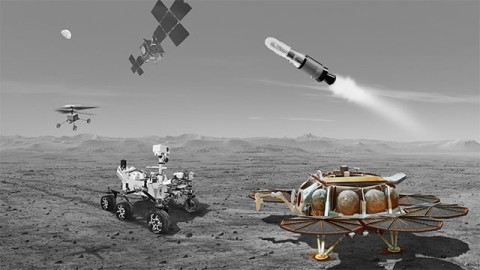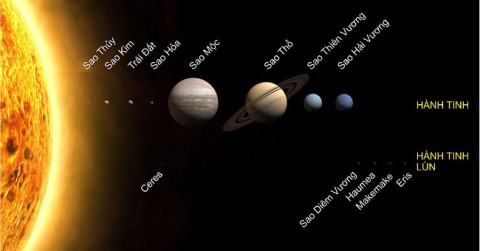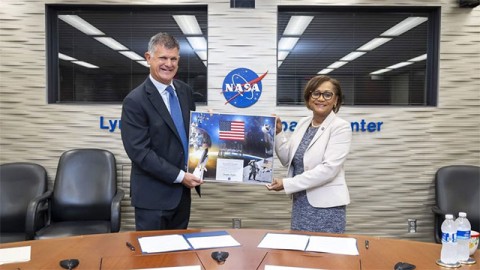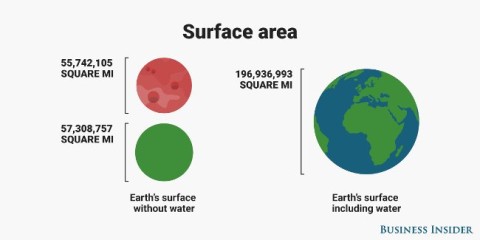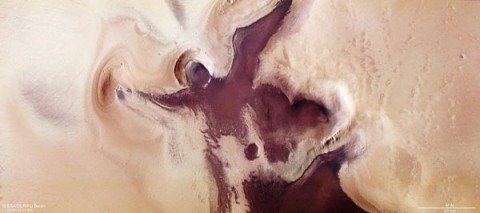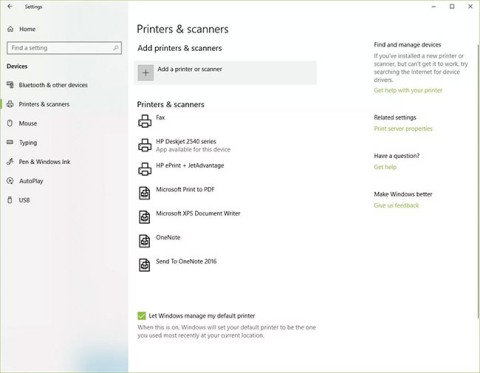Enjoy this 2.5 billion pixel photo of a detailed panorama of Mars
On September 14, NASA shared the most detailed image of the surface of Mars ever, along with a video that gives us a new and clearest panoramic view of the surface of the red planet.
How big is Mars ? Not only the area of Mars , the article will tell you more about the 4th planet - Mars.
Mars is the fourth planet from the sun and has a distinctive rusty red appearance and two unusual moons.
Mars, also known as the Red Planet, is a cold, desert world in our solar system. It has a very thin atmosphere, but this dusty, lifeless (as far as we know) planet is anything but dull.
Spectacular dust storms can grow so large that they engulf the entire planet, temperatures can drop so low that atmospheric carbon dioxide condenses directly into snow or ice, and Martian earthquakes regularly shake things up. So it’s no surprise that this little red rock continues to intrigue scientists and is one of the most explored bodies in the solar system, according to NASA Science. Here’s what you need to know about Mars.
Mars' position in the solar system
Mars coordinates: RA 21h 59m 15s | Inclination -14° 14′ 1″.
Mars is the fourth planet from the Sun in the Solar System . The average orbital distance of Mars from the Sun is about 230 million km (1.5 AU). The shortest distance between Mars and Earth is 57 million km.
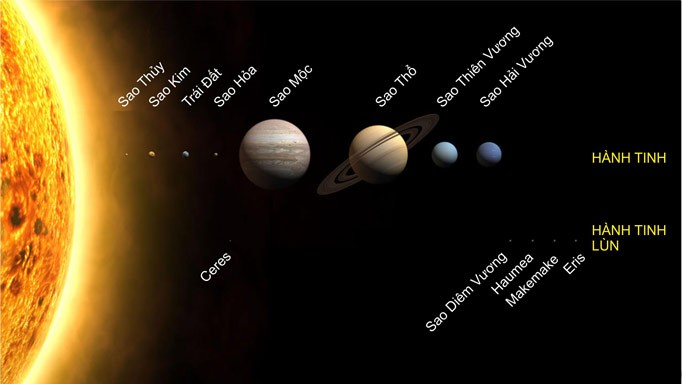
Size, mass of Mars
At the equator, Mars is 4,222 miles (6,784 km) in diameter, and 4,196 miles (6,752 km) pole-to-pole. It is the second-smallest planet in the Solar System, larger only than Mercury. Mars is about half (53%) the size of Earth. The area of Mars is approximately equal to the total land area of Earth.
Mars weighs about 6.39E23 kg, which is 11% of the mass of Earth.

The volume of Mars is 163 billion km3, which is about 15% of the volume of Earth (1083 billion km3). It would take 6 Martians to fill our planet.
The density of the Red Planet is 3.93 g/cm³, less than that of Earth (5.51 g/cm³).
Orbit and rotation period of Mars
The orbital period of Mars is 687 days. A day on the Red Planet lasts 24 hours, 39 minutes, and 35.244 seconds (a day on Earth is 24 hours). A year on Mars is 1.8809 Earth years or 1 year, 320 days, and 18.2 hours.
Mars's axial tilt is 25.19 degrees, which is larger than Earth's 23.4 degrees.
Mars' orbit is very elliptical, so its distance from the Sun is constantly changing. Earth's orbit is nearly circular, so the distance between the Earth and the Sun remains almost constant throughout the year.
Water and atmosphere on Mars
Compared to Earth, Mars' atmosphere is quite thin, containing 95% carbon dioxide, 3% nitrogen, 1.6% argon, and traces of oxygen and water vapor.
The atmospheric pressure on Mars is only 1/100 that on Earth.
Water on Mars exists in solid form in the soil, and as ice sheets at the poles.
The average temperature on the Red Planet is around -60 degrees Celsius. However, temperatures near the poles in winter can drop to -125 degrees Celsius and temperatures at the equator during the day can rise to 20 degrees Celsius.
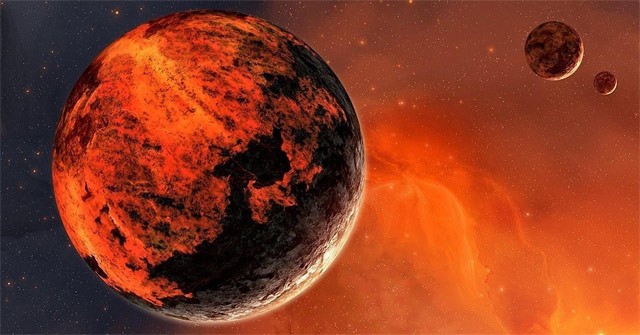
Composition of Mars
Dust Crust: The surface of Mars is covered by a fine layer of dust. Beneath the dust is a Martian crust about 50km thick, mainly made up of volcanic basalt.
Mantle: The mantle is about 5,400 to 7,200 km deep, and is composed mainly of silicon, oxygen, iron, and magnesium.
Solid core: Located at the center of Mars, it is made up of iron, nickel, and sulfur. It is about 3,000 to 4,000 km in diameter. Mars does not have a magnetic field because the core is not moving.
Moon of Mars
The two moons of Mars, Phobos and Deimos, were discovered by American astronomer Asaph Hall within a week of each other in 1877. Hall had almost given up on finding the Martian moons, but his wife, Angelina, urged him on. He discovered Deimos the following night, and Phobos six days later. He named the moons after the sons of the Greek god of war Ares—Phobos means "fear," while Deimos means "defeat."
Both Phobos and Deimos appear to be made of carbon-rich rock mixed with ice and covered with dust and loose rocks. They are very small compared to Earth's moon and are irregularly shaped, since they lack the gravity to pull themselves into a more circular shape. Phobos is about 17 miles (27 kilometers) wide at its widest, and Deimos is about 9 miles (15 kilometers) wide at its widest. (Earth's moon is 2,159 miles, or 3,475 kilometers, wide.)
Both Martian moons are riddled with impact craters. Phobos also has a complex pattern of grooves on its surface, which may be cracks formed after the impact that created the moon’s largest crater — a hole about 6 miles (10 kilometers) wide, or nearly half the width of Phobos. The two Martian moons always face the same side toward their parent planet, just as our moon faces Earth.
On September 14, NASA shared the most detailed image of the surface of Mars ever, along with a video that gives us a new and clearest panoramic view of the surface of the red planet.
NASA has big goals for Mars. The agency wants to collect the first samples from the Martian surface and return them to Earth in an ambitious mission called Mars Sample Return.
How big is the diameter of the solar system? This article will give you the answer.
One of the world's leading energy corporations BP has recently signed an ambitious cooperation agreement with NASA, with the aim of applying advanced mining technology available on Earth to drill for hidden resources on the moon.
Mars is one of the most interesting planets. Here are some little known facts about Mars.
Scientists have photographed many strange things on Mars, from spoons, squirrels, blueberries to the shadow of a woman… but no one is sure if they are real or not.
Diet is important to our health. Yet most of our meals are lacking in these six important nutrients.
At first glance, AirPods look just like any other true wireless earbuds. But that all changed when a few little-known features were discovered.
In this article, we will guide you how to regain access to your hard drive when it fails. Let's follow along!
Dental floss is a common tool for cleaning teeth, however, not everyone knows how to use it properly. Below are instructions on how to use dental floss to clean teeth effectively.
Building muscle takes time and the right training, but its something anyone can do. Heres how to build muscle, according to experts.
In addition to regular exercise and not smoking, diet is one of the best ways to protect your heart. Here are the best diets for heart health.
The third trimester is often the most difficult time to sleep during pregnancy. Here are some ways to treat insomnia in the third trimester.
There are many ways to lose weight without changing anything in your diet. Here are some scientifically proven automatic weight loss or calorie-burning methods that anyone can use.
Apple has introduced iOS 26 – a major update with a brand new frosted glass design, smarter experiences, and improvements to familiar apps.
Yoga can provide many health benefits, including better sleep. Because yoga can be relaxing and restorative, its a great way to beat insomnia after a busy day.
The flower of the other shore is a unique flower, carrying many unique meanings. So what is the flower of the other shore, is the flower of the other shore real, what is the meaning and legend of the flower of the other shore?
Craving for snacks but afraid of gaining weight? Dont worry, lets explore together many types of weight loss snacks that are high in fiber, low in calories without making you try to starve yourself.
Prioritizing a consistent sleep schedule and evening routine can help improve the quality of your sleep. Heres what you need to know to stop tossing and turning at night.
Adding a printer to Windows 10 is simple, although the process for wired devices will be different than for wireless devices.
You want to have a beautiful, shiny, healthy nail quickly. The simple tips for beautiful nails below will be useful for you.
